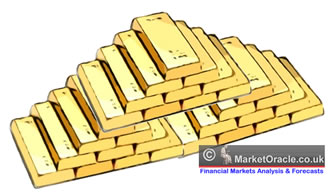Surging Commodity Prices the Unintended Consequences of Printing Money
Commodities / Quantitative Easing Jun 12, 2009 - 09:33 AM GMT Mike Larson writes: So let me see if I get this straight. From their recent lows …
Mike Larson writes: So let me see if I get this straight. From their recent lows …
Crude oil prices have more than doubled — to $72 a barrel from $33.55.
Crude oil prices have more than doubled — to $72 a barrel from $33.55.
Gasoline prices have surged 62 percent to $2.62 a gallon from $1.62.
Gold prices have tacked on $147 an ounce. Platinum is up 27 percent and silver has soared 45 percent.
Wheat prices are up 17 percent, soybeans have jumped 49 percent, and corn has rocketed 25 percent.
At the same time, the difference in interest rates between 2-year and 10-year Treasuries has vaulted to 260 basis points. That’s just shy of an all-time record — a warning sign from the bond market that investors are mad as hell, and not willing to buy longer-term debt.
Meanwhile, the 10-year TIPS spread, or the difference between yields on 10-year nominal Treasuries and yields on 10-year Treasury Inflation Protected Securities, has blown out to 210 basis points from close to zero a few months ago. That’s another warning sign of rising inflation fears.
 |
| Rising prices for agricultural commodities, like wheat, are the unintended consequences of the Fed’s attempts at bailing out anyone and everyone. |
The unambiguous message: Federal Reserve money printing is out of control!
We’re seeing a replay of the 2007-2008 easy money-driven commodity and resource inflation — the unintended consequences of the Fed’s attempts at bailing out anyone and everyone.
Warning Signs Everywhere …
While Fed Chairman Ben Bernanke and his buddies are whistling Dixie in Washington, those of us in the real world are seeing warning signs of these unintended consequences everywhere …
From The Financial Times, June 10:
“After a year of worrying about the piggy bank, the world economy is turning its attention to the cupboard.
“Almost unnoticed, agricultural commodities prices have returned to levels last seen at the start of the 2007-2008 food crisis, prompting concerns about a fresh rise in food costs.”
Or how about this story from The New York Times, dated June 8:
“After just a few months of relief at the pump, cheap gasoline is disappearing.
“Gas prices have risen 41 days in a row, to a national average of almost $2.62 a gallon. That is a sharp increase from the low of $1.62 a gallon that prevailed at the end of last year … The national jump in prices, far larger than the normal seasonal increase, is pulling billions of dollars from the pockets of drivers. It threatens to curtail a modest recovery in consumer spending on items like apparel and electronics.”
The common thread here: Speculation, driven by easy money.
The Fed is debasing the value of our currency, driving investment dollars into dollar hedges. There’s so much money coursing through the markets, in fact, that it’s almost impossible to grasp!
Consider the following from The Wall Street Journal, also on June 10:
“About eight months ago, starting in early September 2008, the Bernanke Fed did an abrupt about-face and radically increased the monetary base — which is comprised of currency in circulation, member bank reserves held at the Fed, and vault cash — by a little less than $1 trillion. The Fed controls the monetary base 100% and does so by purchasing and selling assets in the open market. By such a radical move, the Fed signaled a 180-degree shift in its focus from an anti-inflation position to an anti-deflation position.
“The percentage increase in the monetary base is the largest increase in the past 50 years by a factor of 10. It is so far outside the realm of our prior experiential base that historical comparisons are rendered difficult if not meaningless. The currency-in-circulation component of the monetary base — which prior to the expansion had comprised 95% of the monetary base — has risen by a little less than 10%, while bank reserves have increased almost 20-fold. Now the currency-in-circulation component of the monetary base is a smidgen less than 50% of the monetary base.”
Yikes!
 |
| Helicopter Ben is dropping money from the sky. The problem is he can’t control where it lands! |
In other words, Helicopter Ben is flying toward the coastline, guns blazing — kind of like Colonel Kilgore in Apocalypse Now. I can almost hear the strains of “Flight of the Valkyries” every time I login to my computer in the morning.
See, the real problem with Bernanke’s approach is this …
You Can Create More Money … You Just Can’t Channel Where It Goes!
The real problem with all this pump-priming, money printing, or whatever you want to call it is simple: It’s like lava flowing downhill. It steamrolls everything in its path, despite all your best efforts to re-direct it.
Look …
- The Fed tried to paper over the Long-Term Capital Management blow up with easy money and rate cuts. That helped launch the last leg of the dot-com bubble …
- The Fed tried to paper over that bust with easy money and low rates, and helped create the biggest housing bubble in U.S. history …
- Then the Fed tried to paper over the housing bust with easy money, and that helped inflate commodities bubble #1 …
Now, it’s trying to paper over the deep recession with … you guessed it … a gigantic wave of easy money! That’s giving us “The Son of Bubble” in some markets and laying the groundwork for a bigger inflation problem down the road.
I hear a lot of talk about how the Fed will supposedly be better this time. Some argue that it will pull back all this excess liquidity at just the right time, helping steer the economy through the twin threats of inflation and deflation with the greatest of ease.
 |
| As the Fed tries papering over the deep recession with a gigantic wave of easy money, consider protecting yourself with dollar hedges, such as gold. |
All I have to say is, “Are you kidding me?”
These guys have been getting it wrong for years now, and we’ve lived through rolling bubbles as a result! Now they, along with the Treasury, appear to be working on a new one, devaluing our hard-earned dollars, and burying our children under the biggest debt burden in world history.
My suggestion: Consider protecting yourself from this monetary insanity with the right combination of gold, other dollar hedges, and investments targeted at the world’s hottest resources markets. And please, please, PLEASE continue to avoid the long end of the bond market, which has gotten absolutely thrashed — just as I predicted it would months ago.
Until next time,
Mike
This investment news is brought to you by Money and Markets . Money and Markets is a free daily investment newsletter from Martin D. Weiss and Weiss Research analysts offering the latest investing news and financial insights for the stock market, including tips and advice on investing in gold, energy and oil. Dr. Weiss is a leader in the fields of investing, interest rates, financial safety and economic forecasting. To view archives or subscribe, visit http://www.moneyandmarkets.com .
Money and Markets Archive |
© 2005-2022 http://www.MarketOracle.co.uk - The Market Oracle is a FREE Daily Financial Markets Analysis & Forecasting online publication.



